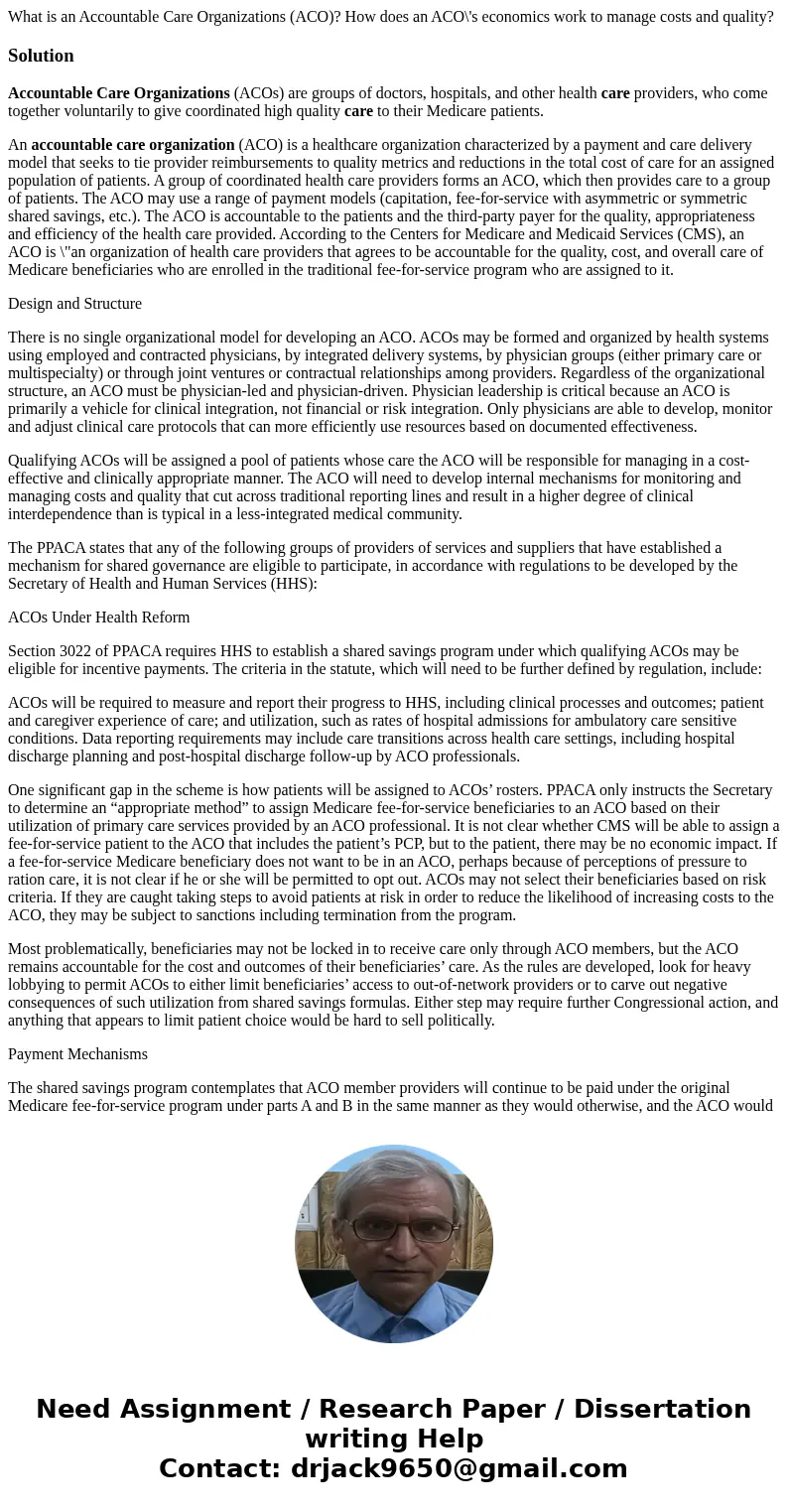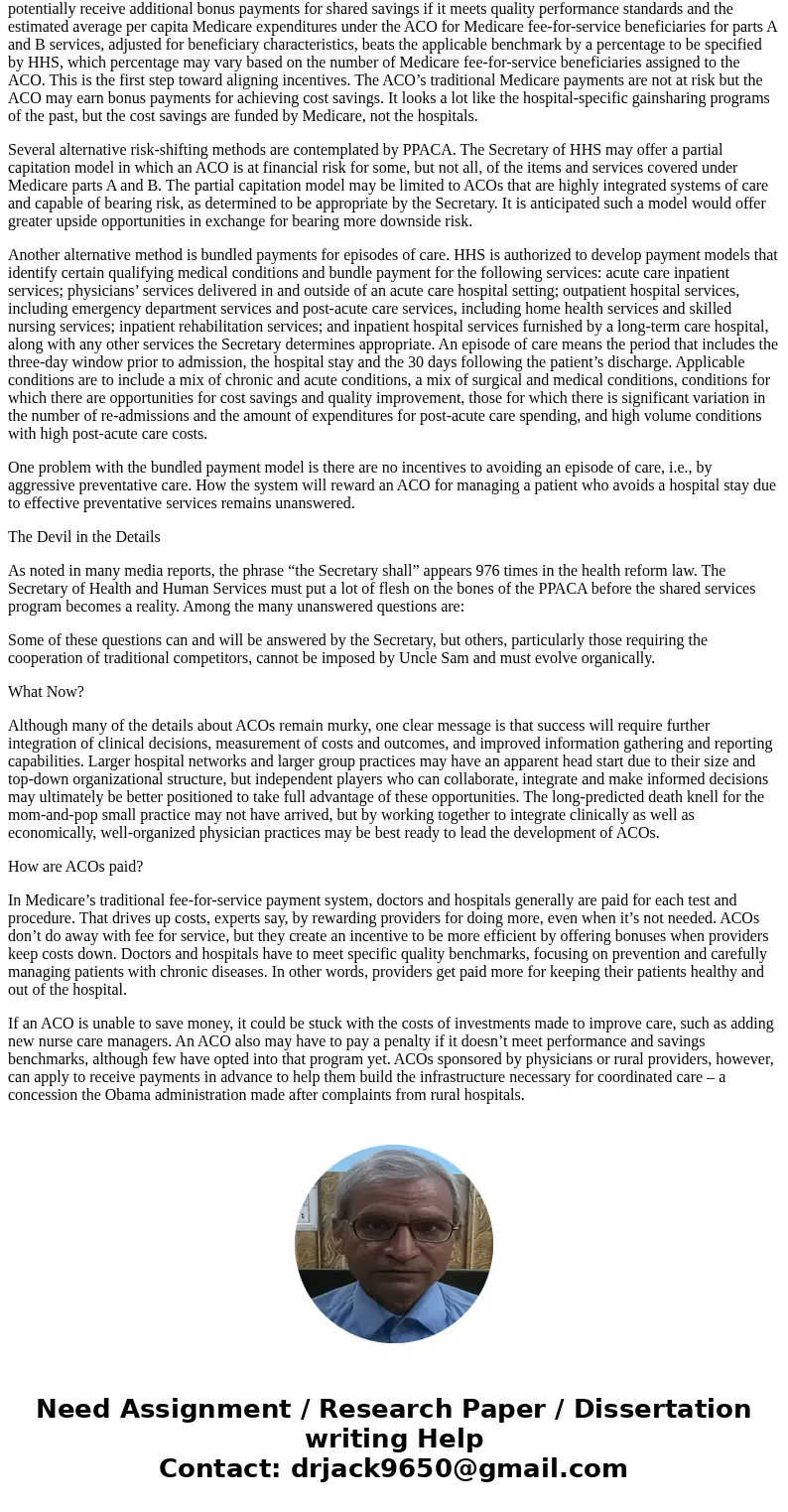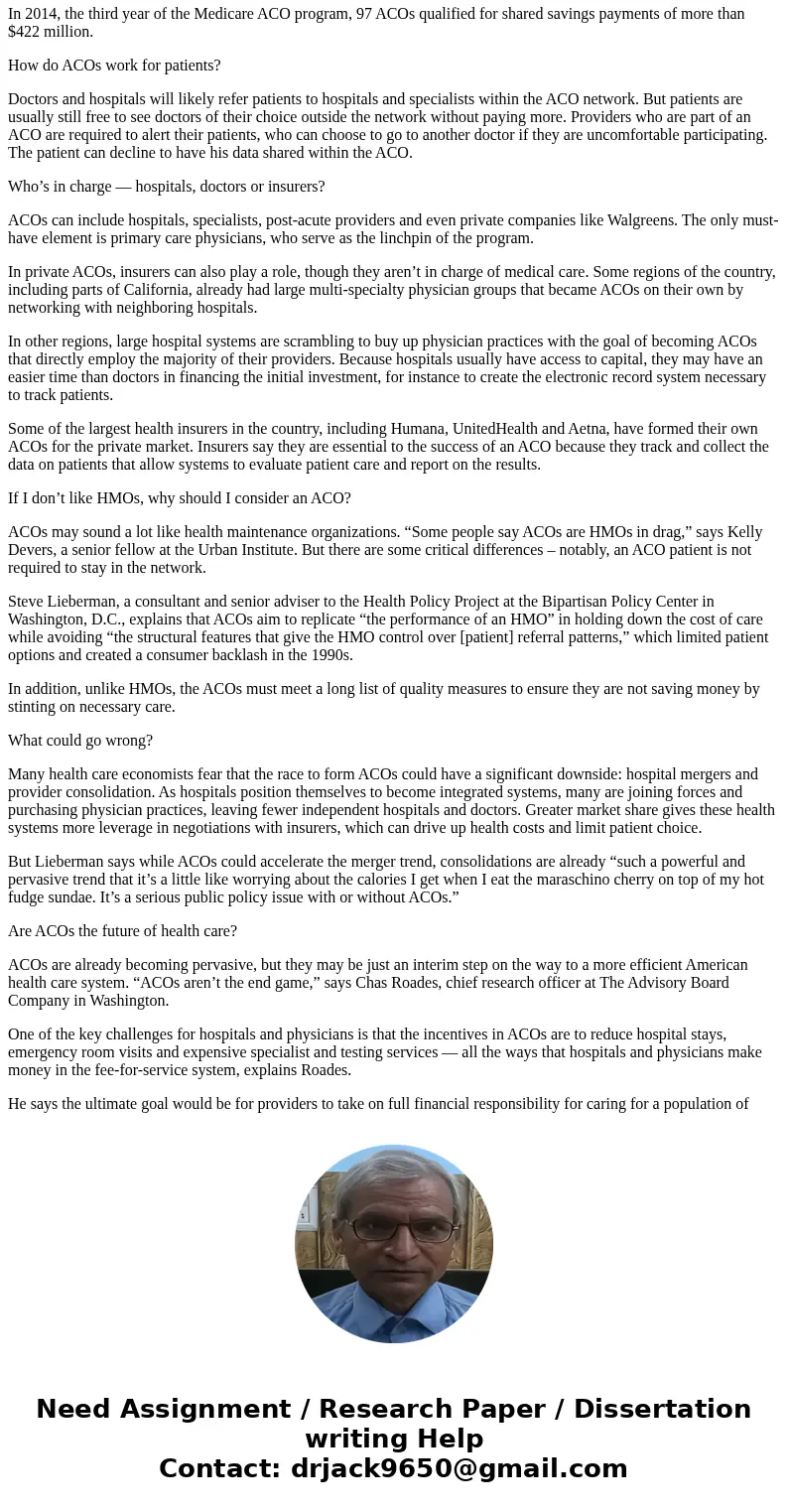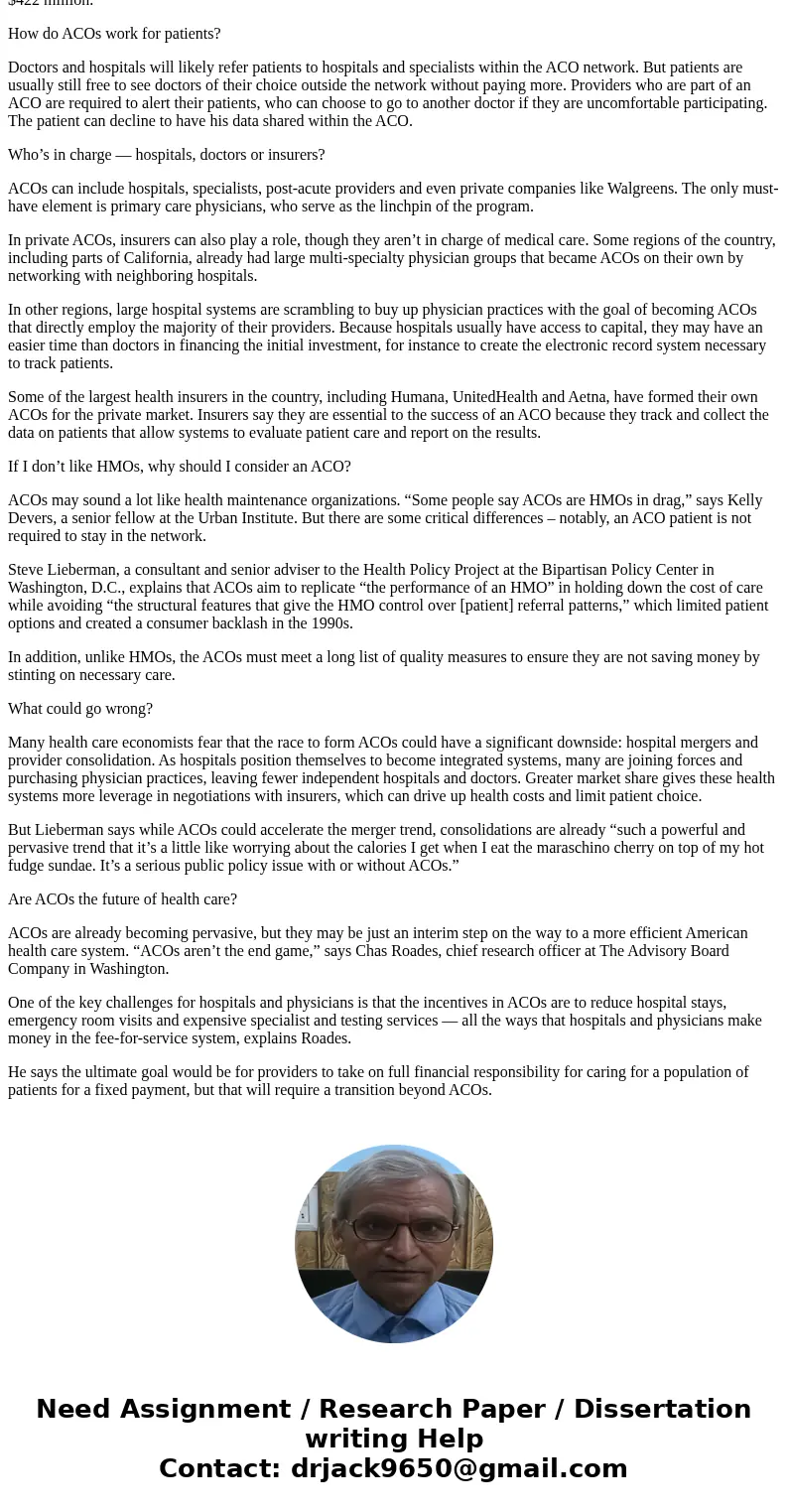What is an Accountable Care Organizations ACO How does an AC
What is an Accountable Care Organizations (ACO)? How does an ACO\'s economics work to manage costs and quality?
Solution
Accountable Care Organizations (ACOs) are groups of doctors, hospitals, and other health care providers, who come together voluntarily to give coordinated high quality care to their Medicare patients.
An accountable care organization (ACO) is a healthcare organization characterized by a payment and care delivery model that seeks to tie provider reimbursements to quality metrics and reductions in the total cost of care for an assigned population of patients. A group of coordinated health care providers forms an ACO, which then provides care to a group of patients. The ACO may use a range of payment models (capitation, fee-for-service with asymmetric or symmetric shared savings, etc.). The ACO is accountable to the patients and the third-party payer for the quality, appropriateness and efficiency of the health care provided. According to the Centers for Medicare and Medicaid Services (CMS), an ACO is \"an organization of health care providers that agrees to be accountable for the quality, cost, and overall care of Medicare beneficiaries who are enrolled in the traditional fee-for-service program who are assigned to it.
Design and Structure
There is no single organizational model for developing an ACO. ACOs may be formed and organized by health systems using employed and contracted physicians, by integrated delivery systems, by physician groups (either primary care or multispecialty) or through joint ventures or contractual relationships among providers. Regardless of the organizational structure, an ACO must be physician-led and physician-driven. Physician leadership is critical because an ACO is primarily a vehicle for clinical integration, not financial or risk integration. Only physicians are able to develop, monitor and adjust clinical care protocols that can more efficiently use resources based on documented effectiveness.
Qualifying ACOs will be assigned a pool of patients whose care the ACO will be responsible for managing in a cost-effective and clinically appropriate manner. The ACO will need to develop internal mechanisms for monitoring and managing costs and quality that cut across traditional reporting lines and result in a higher degree of clinical interdependence than is typical in a less-integrated medical community.
The PPACA states that any of the following groups of providers of services and suppliers that have established a mechanism for shared governance are eligible to participate, in accordance with regulations to be developed by the Secretary of Health and Human Services (HHS):
ACOs Under Health Reform
Section 3022 of PPACA requires HHS to establish a shared savings program under which qualifying ACOs may be eligible for incentive payments. The criteria in the statute, which will need to be further defined by regulation, include:
ACOs will be required to measure and report their progress to HHS, including clinical processes and outcomes; patient and caregiver experience of care; and utilization, such as rates of hospital admissions for ambulatory care sensitive conditions. Data reporting requirements may include care transitions across health care settings, including hospital discharge planning and post-hospital discharge follow-up by ACO professionals.
One significant gap in the scheme is how patients will be assigned to ACOs’ rosters. PPACA only instructs the Secretary to determine an “appropriate method” to assign Medicare fee-for-service beneficiaries to an ACO based on their utilization of primary care services provided by an ACO professional. It is not clear whether CMS will be able to assign a fee-for-service patient to the ACO that includes the patient’s PCP, but to the patient, there may be no economic impact. If a fee-for-service Medicare beneficiary does not want to be in an ACO, perhaps because of perceptions of pressure to ration care, it is not clear if he or she will be permitted to opt out. ACOs may not select their beneficiaries based on risk criteria. If they are caught taking steps to avoid patients at risk in order to reduce the likelihood of increasing costs to the ACO, they may be subject to sanctions including termination from the program.
Most problematically, beneficiaries may not be locked in to receive care only through ACO members, but the ACO remains accountable for the cost and outcomes of their beneficiaries’ care. As the rules are developed, look for heavy lobbying to permit ACOs to either limit beneficiaries’ access to out-of-network providers or to carve out negative consequences of such utilization from shared savings formulas. Either step may require further Congressional action, and anything that appears to limit patient choice would be hard to sell politically.
Payment Mechanisms
The shared savings program contemplates that ACO member providers will continue to be paid under the original Medicare fee-for-service program under parts A and B in the same manner as they would otherwise, and the ACO would potentially receive additional bonus payments for shared savings if it meets quality performance standards and the estimated average per capita Medicare expenditures under the ACO for Medicare fee-for-service beneficiaries for parts A and B services, adjusted for beneficiary characteristics, beats the applicable benchmark by a percentage to be specified by HHS, which percentage may vary based on the number of Medicare fee-for-service beneficiaries assigned to the ACO. This is the first step toward aligning incentives. The ACO’s traditional Medicare payments are not at risk but the ACO may earn bonus payments for achieving cost savings. It looks a lot like the hospital-specific gainsharing programs of the past, but the cost savings are funded by Medicare, not the hospitals.
Several alternative risk-shifting methods are contemplated by PPACA. The Secretary of HHS may offer a partial capitation model in which an ACO is at financial risk for some, but not all, of the items and services covered under Medicare parts A and B. The partial capitation model may be limited to ACOs that are highly integrated systems of care and capable of bearing risk, as determined to be appropriate by the Secretary. It is anticipated such a model would offer greater upside opportunities in exchange for bearing more downside risk.
Another alternative method is bundled payments for episodes of care. HHS is authorized to develop payment models that identify certain qualifying medical conditions and bundle payment for the following services: acute care inpatient services; physicians’ services delivered in and outside of an acute care hospital setting; outpatient hospital services, including emergency department services and post-acute care services, including home health services and skilled nursing services; inpatient rehabilitation services; and inpatient hospital services furnished by a long-term care hospital, along with any other services the Secretary determines appropriate. An episode of care means the period that includes the three-day window prior to admission, the hospital stay and the 30 days following the patient’s discharge. Applicable conditions are to include a mix of chronic and acute conditions, a mix of surgical and medical conditions, conditions for which there are opportunities for cost savings and quality improvement, those for which there is significant variation in the number of re-admissions and the amount of expenditures for post-acute care spending, and high volume conditions with high post-acute care costs.
One problem with the bundled payment model is there are no incentives to avoiding an episode of care, i.e., by aggressive preventative care. How the system will reward an ACO for managing a patient who avoids a hospital stay due to effective preventative services remains unanswered.
The Devil in the Details
As noted in many media reports, the phrase “the Secretary shall” appears 976 times in the health reform law. The Secretary of Health and Human Services must put a lot of flesh on the bones of the PPACA before the shared services program becomes a reality. Among the many unanswered questions are:
Some of these questions can and will be answered by the Secretary, but others, particularly those requiring the cooperation of traditional competitors, cannot be imposed by Uncle Sam and must evolve organically.
What Now?
Although many of the details about ACOs remain murky, one clear message is that success will require further integration of clinical decisions, measurement of costs and outcomes, and improved information gathering and reporting capabilities. Larger hospital networks and larger group practices may have an apparent head start due to their size and top-down organizational structure, but independent players who can collaborate, integrate and make informed decisions may ultimately be better positioned to take full advantage of these opportunities. The long-predicted death knell for the mom-and-pop small practice may not have arrived, but by working together to integrate clinically as well as economically, well-organized physician practices may be best ready to lead the development of ACOs.
How are ACOs paid?
In Medicare’s traditional fee-for-service payment system, doctors and hospitals generally are paid for each test and procedure. That drives up costs, experts say, by rewarding providers for doing more, even when it’s not needed. ACOs don’t do away with fee for service, but they create an incentive to be more efficient by offering bonuses when providers keep costs down. Doctors and hospitals have to meet specific quality benchmarks, focusing on prevention and carefully managing patients with chronic diseases. In other words, providers get paid more for keeping their patients healthy and out of the hospital.
If an ACO is unable to save money, it could be stuck with the costs of investments made to improve care, such as adding new nurse care managers. An ACO also may have to pay a penalty if it doesn’t meet performance and savings benchmarks, although few have opted into that program yet. ACOs sponsored by physicians or rural providers, however, can apply to receive payments in advance to help them build the infrastructure necessary for coordinated care – a concession the Obama administration made after complaints from rural hospitals.
In 2014, the third year of the Medicare ACO program, 97 ACOs qualified for shared savings payments of more than $422 million.
How do ACOs work for patients?
Doctors and hospitals will likely refer patients to hospitals and specialists within the ACO network. But patients are usually still free to see doctors of their choice outside the network without paying more. Providers who are part of an ACO are required to alert their patients, who can choose to go to another doctor if they are uncomfortable participating. The patient can decline to have his data shared within the ACO.
Who’s in charge — hospitals, doctors or insurers?
ACOs can include hospitals, specialists, post-acute providers and even private companies like Walgreens. The only must-have element is primary care physicians, who serve as the linchpin of the program.
In private ACOs, insurers can also play a role, though they aren’t in charge of medical care. Some regions of the country, including parts of California, already had large multi-specialty physician groups that became ACOs on their own by networking with neighboring hospitals.
In other regions, large hospital systems are scrambling to buy up physician practices with the goal of becoming ACOs that directly employ the majority of their providers. Because hospitals usually have access to capital, they may have an easier time than doctors in financing the initial investment, for instance to create the electronic record system necessary to track patients.
Some of the largest health insurers in the country, including Humana, UnitedHealth and Aetna, have formed their own ACOs for the private market. Insurers say they are essential to the success of an ACO because they track and collect the data on patients that allow systems to evaluate patient care and report on the results.
If I don’t like HMOs, why should I consider an ACO?
ACOs may sound a lot like health maintenance organizations. “Some people say ACOs are HMOs in drag,” says Kelly Devers, a senior fellow at the Urban Institute. But there are some critical differences – notably, an ACO patient is not required to stay in the network.
Steve Lieberman, a consultant and senior adviser to the Health Policy Project at the Bipartisan Policy Center in Washington, D.C., explains that ACOs aim to replicate “the performance of an HMO” in holding down the cost of care while avoiding “the structural features that give the HMO control over [patient] referral patterns,” which limited patient options and created a consumer backlash in the 1990s.
In addition, unlike HMOs, the ACOs must meet a long list of quality measures to ensure they are not saving money by stinting on necessary care.
What could go wrong?
Many health care economists fear that the race to form ACOs could have a significant downside: hospital mergers and provider consolidation. As hospitals position themselves to become integrated systems, many are joining forces and purchasing physician practices, leaving fewer independent hospitals and doctors. Greater market share gives these health systems more leverage in negotiations with insurers, which can drive up health costs and limit patient choice.
But Lieberman says while ACOs could accelerate the merger trend, consolidations are already “such a powerful and pervasive trend that it’s a little like worrying about the calories I get when I eat the maraschino cherry on top of my hot fudge sundae. It’s a serious public policy issue with or without ACOs.”
Are ACOs the future of health care?
ACOs are already becoming pervasive, but they may be just an interim step on the way to a more efficient American health care system. “ACOs aren’t the end game,” says Chas Roades, chief research officer at The Advisory Board Company in Washington.
One of the key challenges for hospitals and physicians is that the incentives in ACOs are to reduce hospital stays, emergency room visits and expensive specialist and testing services — all the ways that hospitals and physicians make money in the fee-for-service system, explains Roades.
He says the ultimate goal would be for providers to take on full financial responsibility for caring for a population of patients for a fixed payment, but that will require a transition beyond ACOs.




 Homework Sourse
Homework Sourse